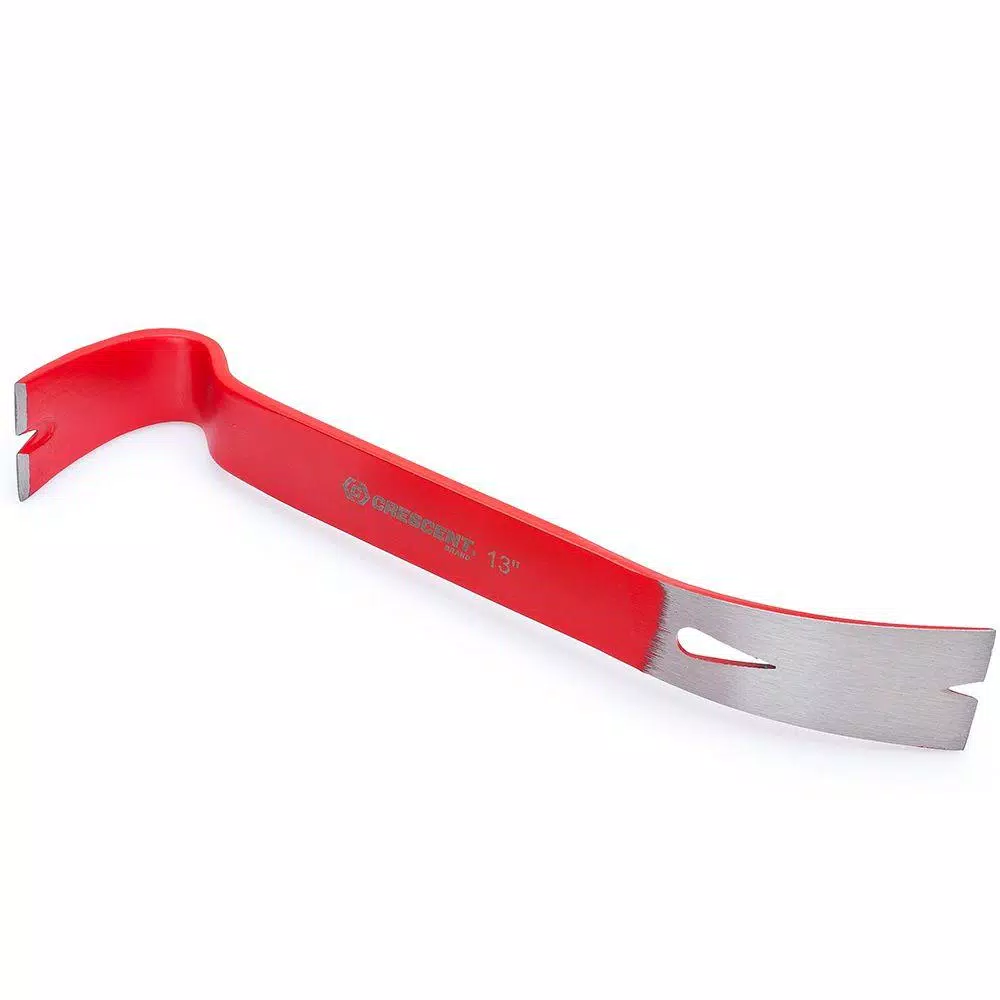Crescent 13 in. Flat Pry Bar
$7.99
The Crescent brand adjustable wrench, celebrating its 105th Anniversary in 2012, is the flagship product of the brand. A true American icon, it is prized by tradesman and homeowners alike for its utility and durability. Today, the Crescent brand can be found on many other high quality tools, including tongue and groove pliers and locking pliers.
In stock
Description
The Crescent brand adjustable wrench, celebrating its 105th Anniversary in 2012, is the flagship product of the brand. A true American icon, it is prized by tradesman and homeowners alike for its utility and durability. Today, the Crescent brand can be found on many other high quality tools, including tongue and groove pliers and locking pliers.
- Crescent code red flat pry bar is 1 item in a full line of innovative demolition, renovation and construction tools by Crescent
- Precision ground ends for nail pulling with less material damage
- Nail slot in end and center for access to pulling nails
- Durable high visibility red finish is corrosion-resistant
- Radius end design adds strength and provides better prying leverage
Additional information
| Weight | 1.46 lbs |
|---|---|
| Dimensions | 15.50 × 3.25 × 3.00 in |
| Assembled Depth (in.) | 15.50 in |
| Assembled Height (in.) | 3.00 in |
| Assembled Width (in.) | 3.25 in |
| Bar length (in.) | 13 |
| Hand Tool Type | Pry Bar |
| Individual/Set | Individual |
| Model | FB13 |
| Number of Pieces | 1 |
| Number of nail slots | 2 |
| Tools Product Type | Hand Tool |
Reviews (5)
5 reviews for Crescent 13 in. Flat Pry Bar
Only logged in customers who have purchased this product may leave a review.
Related products
Wrecking & Pry Bars
Model# DWHT55132Wrecking & Pry Bars
Model# 55-033Wrecking & Pry Bars
Model# 55-119Wrecking & Pry Bars
Model# 2125Wrecking & Pry Bars
Model# PC300GWrecking & Pry Bars
Model# 2126Wrecking & Pry Bars
Model# HC-10Wrecking & Pry Bars
Model# HB-15















Jo Collier (verified owner) –
Sturdy construction, built to last. I like the smaller size. It can fit into tight places and it still has a good bit of leverage for prying and demo work.
Joelle Hermann (verified owner) –
This is a must have for any toolbox! Durable, versatile, and it does it all. This is the only pry bar you will ever need!
Malvina Block (verified owner) –
I have pry bars but not like this. Heavy weighted….I like that. Versatile prying w/ dual ends. Crescent went out of there way w/ this. I am very enthused abut this pry bar. Really made the difference and it shows in performance.
Vaughn Aufderhar (verified owner) –
This was the best tool I ever used for removing old nails from wood. I had to remove some 2×4’s from a platform to make it shorter and this tool did a great job. It took less then 5 minutes to have the pieces apart and the nails taken out of the old wood. Way better then the claw on a hammer and easier to handle too. I am glad I got this because I reclaim a lot of old wood to use for new projects.
Jayne Schinner (verified owner) –
Well this product is pretty straight forward. Relyable hard steel, no gears or electronics that could go out. If you’ve never used one of these, it is basically a half sized crow bar, but it has a wider pry surface that is better for prying boards apart. Especially since a good 80% of any wood demo work usually deals with rotted wood. With rotted wood when wedging/prying, you need a larger surface of contact to disperse the work load. Where as a typical thin crow bar often times sinks through before actually prying anything off. Another benefit is this size bar you can carry on a tool belt. I mean yes it adds a good (I think) 5 pounds, but much better then a 20pnd crow bar that hangs down to your feet.I used one of these when I did the demo on my deck. I will tell you it makes demo go twice as fast, and much easier. An alternative is a cats paw that dig into the wood to get under the head of the nail so you can then pull the nail, but this will tare up the surface wood, where as this will only damage the back of the wood, and not nearly as much as a catspaw. Note, if you are dealing with screws, they are meant to stay in wood even when they have rusted, and the wood has rotted. While this would work, it will be a pain with screws. Best choice for dealing with screws during demo (if they have stripped heads) is to just take a sawzaw to the entire thing and trash it all. Yes you won’t be able to reuse the wood for much, but if you take the time to unscrew 1000, 4000, 10’s of thousands of screws, time wise it would’ve been cheaper to buy new wood in the future, then to try to recycle the old wood.Biggest thing about these is to have a rough sharpening tool handy (grinder, course belt sander, etc). You don’t exactly keep these razor sharp, but you want a very fine-edge. If/when you do hammer one of these against a nail or something that isn’t soft wood, it’ll leave a knick in the edge. At which point you at least want to grind down to a flat surface with a knick, rather then a protruding knick.I recommend this to anyone doing Demo, or remodeling that has to deal with wood and screws. If it is metal, this will still work, but you will likely destroy the tool by the time you are done (depending on what it is)